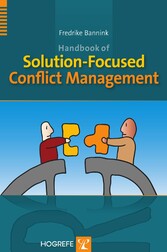Suchen und Finden
Acknowledgments
3
Foreword: Building Bridges Between Psychology and Conflict Resolution — Implications for Mediator Learning
6
Peer Commentaries
8
Table of Contents
10
1 Bloodtaking and Peacemaking
14
Conflict Management Is of All Times and All Species
14
Modern Conflict Management
15
Story 1: Taking a Different View
16
2 Background Issues
18
Introduction
18
Game Theory
18
Quantum Mechanics and Neuroscience
20
Hope Theory
22
Broaden-and-Build Theory of Positive Emotions
27
Story 2: Feeding a Fellow
29
3 Solution-Focused Interviewing
32
Principles of Solution-Focused Interviewing
32
Story 3: Do Something Different
32
Looking to the Future (1)
33
Assumptions With an Eye on Solutions
33
Exercise 1
35
Acknowledgment and Possibilities
35
Microanalysis of Conversations
37
Empirical Evidence
37
Indications and Contraindications
39
Story 4: The Problem of Looking for Problems
39
4 Solution-Focused Conflict Management
42
Four Dimensions in Conflict Thinking
42
Looking to the Future (2)
43
Clients, Parties, Lawyers, and Litigants: What’s in the Name?
45
Exercise 2
45
Differences Between Traditional and Solution-Focused Conflict Management
45
Changing Conflict Stories
47
5 Four Basic Solution-Focused Questions
50
Exercise 3
50
Questions about Hope
50
Story 5: The Power of Hope
52
Questions About Differences
52
Case
54
Questions About What Is Already Working
54
Questions About the Next Step or Sign of Progress
55
Case
56
Solution-Focused Conflict Management in Practice
56
Exercise 4
59
6 More Solution-Focused Questions
60
More Questions
60
What Else?
60
Exercise 5
61
Case
61
Premediation Change
61
Interactional Matrix
62
Exercise 6
63
Case
63
Exercise 7
64
Looking to the Future (3): Future-Oriented Questions
64
Exercise 8
65
Story 6: Working from the Future Back
66
Scaling Questions: Hope, Motivation, and Confidence
67
Case
68
Scaling Questions: Respect – Contempt
68
Scaling Questions: Pure Collaboration – Pure Conflict
70
Feedback
71
What Is Better?
72
Exercise 9
73
7 Divorce Mediation
74
Case
74
Compliments
77
Exercise 10
78
Story 7: The Importance of Accepting Compliments
78
8 Working Alliance and Motivation to Change
82
Motivation to Change
82
Visitor, Complainant, or Customer
82
Case
84
Exercise 11
85
Attitude of the Solution-Focused Mediator
85
Resistance Is Not a Useful Concept
86
Case
86
Scaling Motivation, Confidence, and Hope
87
Thomas-Kilmann Conflict Mode Instrument
88
Persuasion Theory
88
Caucus
90
Working Alliance
90
“Supermediators”
91
Exercise 12
93
Motivation of the Mediator
93
Exercise 13
94
9 Neighbor Conflict Mediation
96
Case
96
Normalization
99
Story 8: Drawing Boundaries
99
10 More Solution-Focused Tools
102
Summarizing
102
Focus on Positive Emotions
102
Apologies, Forgiveness, and Reconciliation
105
Case
107
“I Don’t Know”
109
Arguments
109
Externalization of the Conflict
110
Exercise 14
112
Spacing Meetings
112
Metaphors
112
Consensus-Building
113
Solution-Focused Consensus-Building
114
11 Team Mediation
116
Case
116
Exercise 15
118
Game Theory Revisited: Trust
118
“Liquid Trust”
120
The Price to Pay
121
Story 9: Finding Peace
122
12 Client-Directed, Outcome-Informed Conflict Management
124
Client-Directed Conflict Management
124
Outcome-Informed Conflict Management
125
Session Rating Scale
126
13 Family Mediation
128
Case
128
Communication
131
Tolerance
132
14 Brief Comparison with Other Models
134
Exercise 16
134
Building Solutions Is Different from Problem Solving
134
Problem Solving Mediation and Solution-Focused Mediation: A Comparison
136
Transformative Mediation and Solution-Focused Mediation: A Comparison
137
Narrative Mediation and Solution-Focused Mediation: A Comparison
138
Conclusion
139
Research on Feedback
140
15 Personal Injury Mediation
142
Case
142
Seating Arrangements
144
Case
145
Dollars and Cents
146
16 Failures
148
Failures
148
Exercise 17
148
Pathways to Impossibility
149
Case
150
Solution-Focused Questions in Case of Failure
151
Saving Face
151
17 Victim-Offender Mediation
154
Restorative Justice
154
Reconciliation
155
Victim-Offender Mediation
158
Case
161
Epilogue by Fredrike Bannink
162
Epilogue by Kenneth Cloke
164
References
174
Websites
180
Appendices
182
Protocol: First Meeting
183
Protocol: Subsequent Meetings
184
Interactional Matrix
185
Externalization of the Conflict
186
Session Rating Scale (SRS V.3.0)
187
Alle Preise verstehen sich inklusive der gesetzlichen MwSt.










